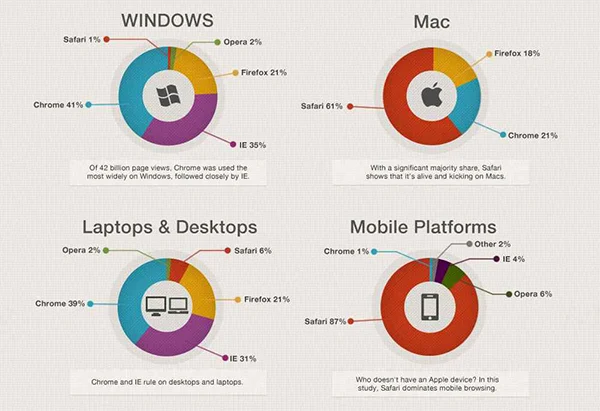
Imagine you are browsing a website on your laptop and for some reason, you need to switch to some other device or browser. You switch and notice that the site settings and UI has also changed. Now you need to figure out everything on that website again.
Sounds frustrating right?
To tackle this problem, building consistency, and enhancing user experience, cross-browser testing is done, and, as David Heinemeier Hansson, the creator of Ruby on Rails, said, “The real test of your app is how it behaves in different browsers.”
Coming back to Cross-browser testing, it is an integral part of the web development and software testing process as it ensures that a web application works effectively on multiple browsers and platforms.
And, as users are divided into hundreds of browser types and versions, cross-browser testing, therefore, forms the necessary ingredient that can make an application compatible, comfortable for the users, or high in application usage.
And if you are wondering which is the most widely used tool for the automation process?
Allow us to introduce you to Selenium– a cross-browser testing tool.
This open-source tool allows writing scripts in several languages by running tests on multiple browsers. However, Selenium alone may be insufficient to carry out full cross-browser testing; the incorporation of other supportive tools can optimize the process of testing.
This article digs deep into best practices for cross-browser testing with Selenium and supporting tools, so your web applications deliver the right user experience across all major browsers.
Why Do We Need Cross-Browser Testing?
Cross-browser testing is done to check, analyze, and compare the functioning of your website in different browsing environments. It ensures that your website offers an optimal user experience regardless of the browser used to access it.
It is a type of non-functional testing. Websites are tested to assess their compatibility with different browsers (Chrome, Firefox, Safari, etc.), different devices (laptops, mobile phones, etc.), and assistive tools such as screen readers for differently abled people.
Cross-browser testing helps in identifying browser-specific errors and allows debugging. Therefore, delivering a uniform experience on different devices and browsers
The following figures represent the most popular browsers by operating systems

It can be inferred from the above facts that cross-browser testing has become an essential tool due to the increasing versions of OSes and devices. It is significant for building site consistency and enhancing the user experience.
Cross-Browser Testing using Selenium
Selenium WebDriver is one of the leaders in Web application automation across multiple browsers. It gives you the ability to interact with the DOM as well as simulate the behavior of the user in order to click, type, scroll, or navigate between pages.
Cross Browser Testing with Selenium: Key Features
- Multi-Browser Support: Selenium works with all the primary browsers, such as Chrome, Firefox, Edge, and Safari, through the specific browser drivers.
- Multi-Platform: It operates on every different OS support, meaning Windows, macOS, and Linux.
- Multiple Language Support: This software enables you to write tests in famous programming languages like Java, Python, C#, Ruby, and JavaScript.
- Parallel Testing: Selenium Grid allows running tests on different browsers and their OS in parallel.
Cross-browser testing by Selenium is very well-supported, but best practices abound in avoiding common pitfalls such as flakiness, slow execution, and poor scalability.
Best Practices for Cross-Browser Testing with Selenium
1. Use the Right Browser Drivers
Browser drivers receive the commands from JSON wire protocol through its HTTP server and send processed requests to the real browser. Ensure that you have the correct and updated version of the browser driver while testing, as it is responsible for the interaction of elements in any operation.
2. Selenium Grid for Parallel Testing
Selenium grids help in running tests on different versions of browsers simultaneously. Testing sites individually can be time-consuming and can act as a limiting factor. It is an open-source project that too for free which makes it a fitting choice.
3. Test Cases Optimization for Different Browsers
Optimization can be done in different ways such as using a cloud-based platform, parallel testing, use of CSS selector, and BDD frameworks.
if (driver instanceof FirefoxDriver) {
// Firefox-specific logic
} else if (driver instanceof ChromeDriver) {
// Chrome-specific logic
}
4. Use Explicit Waits for Stable Tests
Explicit waits are used for handling dynamic elements like Ajax elements that take longer to load. It commands the web driver to wait for a specific condition to be fulfilled before starting the code.
WebDriverWait wait = new WebDriverWait(driver, 10);
wait.until(ExpectedConditions.visibilityOfElementLocated(By.id(“elementId”)));
5. Test on Various Versions of Browsers
There are several versions of browsers such as cloud-based platforms, browser emulators or simulators, etc. Testing on these different versions ensures uniformity and a better user experience.
6. Cross-Platform Testing
Cross-platform testing ensures that the software is working on different platforms and operating systems or not. It helps the software reach a wider crowd through different platforms.
7. Mobile Browser Testing
It involves testing software and website testing on mobile browns with no setups. It helps in confirming if the software functions effortlessly on different viewports.
8. Debugging Browser-Dependent Bugs
Browser-dependent bugs occur when web applications show inconsistency across different platforms. Debugging includes finding the error in the set of computer instructions and modifying it to function properly.
LogEntries logs = driver.manage().logs().get(LogType.BROWSER);
for (LogEntry entry : logs)
{
System.out.println(entry.getMessage());
9. Interaction with CI/CD
Continuous integration(CI) runs automated tests to catch bugs easily and amend it according to the requirements
Continuous delivery (CD) – Helps to integrate, test, and deliver code changes.
Continuous deployment (CD)- Automatically release and implement code changes into production.
10. Browser Prioritization Based on User Analytics
Determining the order in which resources and information are loaded while opening the website based on the user activity and engagement on the website.
DO YOU KNOW?Google Chrome is the most used web browser, dominating the market with 65% of the shares. Apple Safari is the second with 18.6% of the market share.
Tools to Help in Cross-Browser Testing using Selenium
Even though Selenium is highly effective, many other tools out there complement it to help better test cross-browser.
1. LambdaTest
LambdaTest is the leading cloud-based testing platform used by Selenium Python, that provides seamless browser and app testing tools. It can be operated on various testing environments and offers a wide range of OS and browser combinations for testing, significantly reducing time and effort. It also reduces the need for extensive in-house testing infrastructure, hence saving money.
Furthermore, it is considered an ideal tool for modern development teams. It offers features like cross-browser testing, real-time testing, automated selenium testing, responsive testing, and an integration ecosystem, exceptionally catering to diverse testing needs.
2. Katalon
Katalon is a test automation solution often used for both web and mobile applications. It includes several in-built features such as test recording, smart object identification, and low code script authoring.
Katalon fast-forwards teams to automate functional tests right away instead of allocating development time in a test framework.
3. testRigor
testRigor allows a team to write end-to-end UI tests efficiently, create edits, and update different versions of tests, allowing teams to rapidly expand the test coverage.
testRigor creates tests entirely from a user’s perspective, identifying a user’s needs and opinions when they see the application on the screen. Due to the immense stability of tests, some customers even use them for monitoring.
Conclusion
Around 22% of users never return to a site after one bad experience, and 50% will go to different websites to accomplish their goals without changing the browser. Therefore, it is essential to provide consistent and quality experience to the users. Testing websites on different platforms and devices helps find bugs and errors and debug them to provide a better experience to consumers.
Selenium is one of the well-known names in web automation across multiple browsers. The testing with Selenium is cross-browser compliant, which enables a web application to work correctly in varied browsers, different devices, and platforms.
Some other effective cross-browser testing tools are LambdaTest, Katalon, and testRigor for cross-browser testing through which everything works amiss for users.
Whether it is a desktop, mobile device, or older version of browsers, you should maximize your cross-browser test strategy by following the guidelines and tips mentioned in this article to enhance the quality of your web applications.